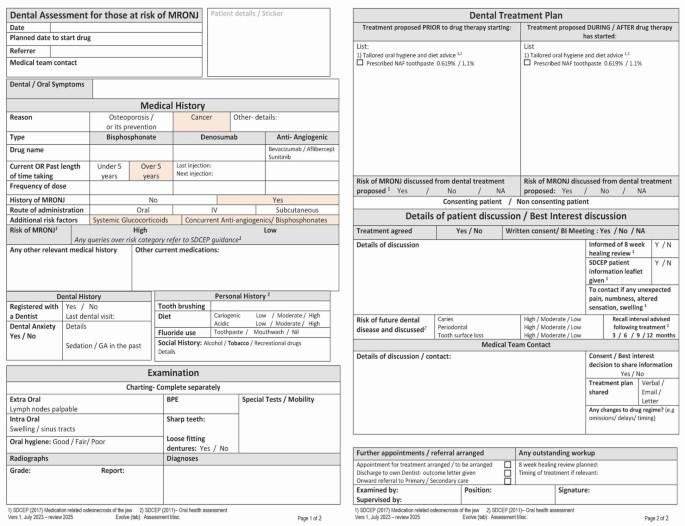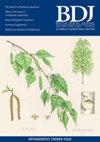Dental assessment pro forma for adult patients at risk of medication-related osteonecrosis of the jaw
IF 2.3
4区 医学
Q2 DENTISTRY, ORAL SURGERY & MEDICINE
引用次数: 0
Abstract
This paper introduces a dental screening pro forma designed for the dental assessment of adult patients who are starting or currently taking medications that pose them at risk of medication-related osteonecrosis of the jaw (MRONJ). Medications considered are those with current Drug Safety Update alerts for MRONJ from the Medications and Healthcare products Regulatory Agency. These include anti-resorptive drugs and some anti-angiogenic drugs. Patients taking these medications face a risk of osteonecrosis from certain dental procedures, dental pathology or chronic trauma. Although rare, MRONJ is difficult to manage once it occurs and can significantly affect a patient's quality of life. The pro forma aligns with national guidance from the Scottish Dental Clinical Effectiveness Programme and The National Institute for Health and Care Excellence, emphasising prevention, risk assessment and tailored oral health management. The pro forma captures information led by the guidance and presents it in a format to enable ongoing auditing and quality improvement. In addition to its diagnostic and monitoring functions, it also has a prevention focus. This aims to help reduce the future need for dental treatment and therefore the likelihood of medication-related osteonecrosis, due to the long-lasting effects of some anti-resorptive drugs. The pro forma is currently implemented in University Hospital Bristol and Weston Primary Care Dental Service, Bristol Dental Hospital and Wiltshire Primary Care Dental Service. It could also be adapted for use in general dental practice or used as a template for referrals.

有药物相关颌骨骨坏死风险的成年患者的牙科评估形式
本文介绍了一种牙科筛查程序,用于对正在开始或正在服用药物的成年患者进行牙科评估,这些患者可能会有药物相关性颌骨骨坏死(MRONJ)的风险。考虑的药物是那些从药物和保健产品监管机构获得MRONJ当前药物安全更新警报的药物。这些药物包括抗吸收药物和一些抗血管生成药物。服用这些药物的患者面临着某些牙科手术、牙科病理或慢性创伤导致骨坏死的风险。MRONJ虽然罕见,但一旦发生就很难控制,而且会严重影响患者的生活质量。该形式与苏格兰牙科临床有效性方案和国家健康与护理卓越研究所的国家指导意见一致,强调预防、风险评估和量身定制的口腔健康管理。预形式获取由指南引导的信息,并以一种能够进行审计和质量改进的格式呈现。除了诊断和监测功能外,它还具有预防功能。这是为了帮助减少未来对牙科治疗的需求,从而减少药物相关骨坏死的可能性,因为一些抗吸收药物的长期作用。目前,布里斯托尔大学医院和韦斯顿初级保健牙科服务、布里斯托尔牙科医院和威尔特郡初级保健牙科服务正在实施这种形式。它也可以适应用于一般牙科实践或用作转诊模板。
本文章由计算机程序翻译,如有差异,请以英文原文为准。
求助全文
约1分钟内获得全文
求助全文
来源期刊

British Dental Journal
医学-牙科与口腔外科
CiteScore
3.10
自引率
15.40%
发文量
1096
审稿时长
4-8 weeks
期刊介绍:
The role of the BDJ is to inform its readers of ideas, opinions, developments and key issues in dentistry - clinical, practical and scientific - stimulating interest, debate and discussion amongst dentists of all disciplines. All papers published in the BDJ are subject to rigorous peer review.
 求助内容:
求助内容: 应助结果提醒方式:
应助结果提醒方式:


